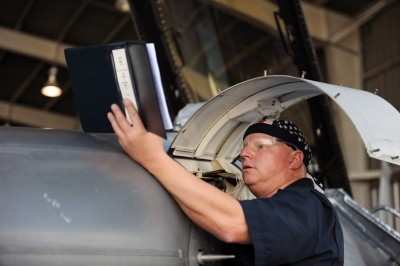126 Retired Fighters Will Become Full-Scale Aerial Targets
Maintenance crews towed F-16 Fighting Falcons out of retirement
from the "boneyard" at Arizona's Davis-Monthan Air Force Base last
week and began preparing them to become the Air Force's newest
platform for target training. Specialists with the 309th Aerospace
Maintenance and Regeneration Group are regenerating F-16s so they
can be flown to a Boeing facility in Florida where they will be
converted to QF-16 full-scale aerial targets.

Civilian Maintenance Tech Chris Clark
Boeing officials received a $69.7 million contract from Air
Force officials in March to convert up to 126 retired F-16s into
QF-16 drones that can fly either manned or unmanned, according to a
Boeing press release. As part of the QF-16 program developmental
phase, Boeing officials tasked 309th AMARG maintainers to
regenerate six F-16s. The maintainers spent more than a year and a
half, an average of about 80 days per aircraft, preparing the first
six aircraft to fly to the Boeing facility. The first F-16 arrived
in at the Boeing facility in April. The fourth is scheduled to fly
out next week, while two are still in the maintenance phase.
"Once we pull the aircraft from storage, we remove all the
panels to conduct our preliminary inspections," said Rob McNichol,
an F-16 aircraft supervisor with the 309th AMARG. "We remove
components so that we can get specialists such as nondestructive
inspection members to find out if the aircraft is going to be
airworthy. If it isn't, then there's no sense doing anything else
to it, and we'll take it back to the desert."
Once an aircraft passes the initial inspections, it is further
disassembled to refurbish, upgrade or replace components. A number
operational checks and test flights are performed to ensure the
aircraft is safe and ready for flight. "We are regenerating these
aircraft from purely storage to a fully-flyable, mission-capable
aircraft," Mr. McNichol said.
Maintainers are converting F-16C models as well as older F-16A
aircraft. Once converted, the QF-16s will replace the few QF-4s
left in the inventory. "We're running out of airworthy airframes,
there's not that many more left," Mr. McNichol said. "The F-16 is a
much lower radar picture which is much needed in modern warfare.
Everyone is getting into smaller profiles, a smaller radar
footprint, which is what the F-16 can give you; plus, it's a lot
faster."

F-16 File Photo
After modification to the QF-16 configuration, the six aircraft
will serve as prototypes for engineering tests and evaluation prior
to production, according to a Boeing press release. Deliveries of
QF-16 drones are scheduled to begin in 2014. "With the advent of
the QF-16 program, we're giving the warfare a better active weapon
system," Mr. McNichols said. "Even though these will be flyable by
a pilot, once they go to the drone packaging they can do everything
unmanned that they can do manned. They'll be used to test new
weapons coming on board, looking at a very small radar signature.
It's just the modernization of it, which we need to keep building
and to become more technically advanced."
ANN Salutes Staff Sgt. Vanessa Young
 ANN's Daily Aero-Linx (05.02.24)
ANN's Daily Aero-Linx (05.02.24) ANN's Daily Aero-Term (05.02.24): Touchdown Zone Lighting
ANN's Daily Aero-Term (05.02.24): Touchdown Zone Lighting Aero-News: Quote of the Day (05.02.24)
Aero-News: Quote of the Day (05.02.24) ANN FAQ: Contributing To Aero-TV
ANN FAQ: Contributing To Aero-TV NTSB Final Report: Cirrus Design Corp SR20
NTSB Final Report: Cirrus Design Corp SR20




